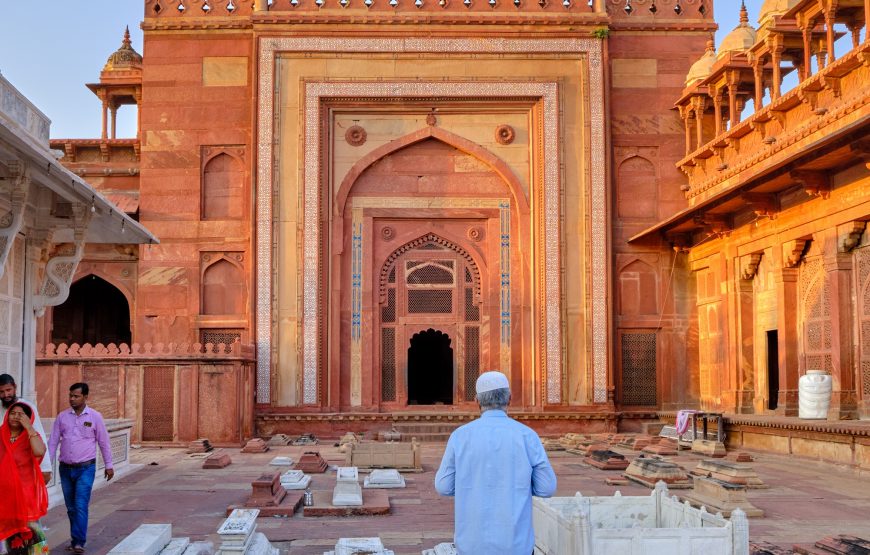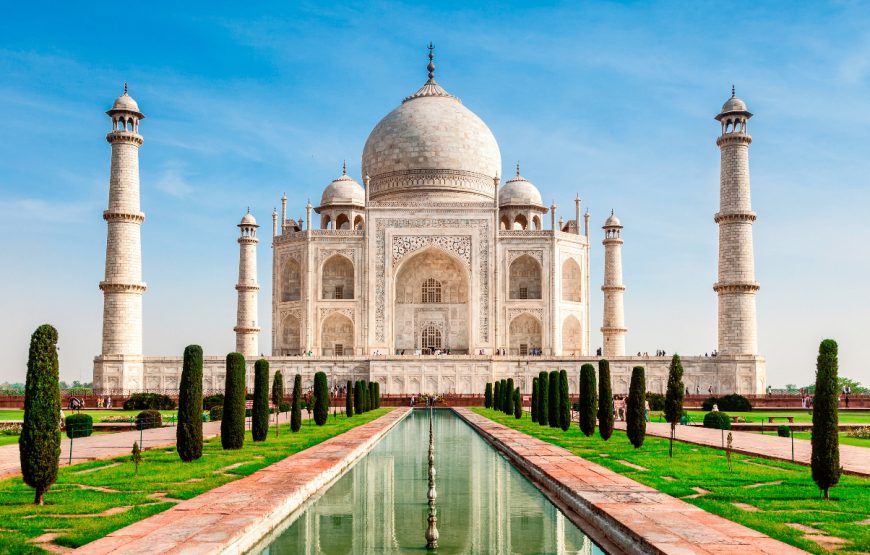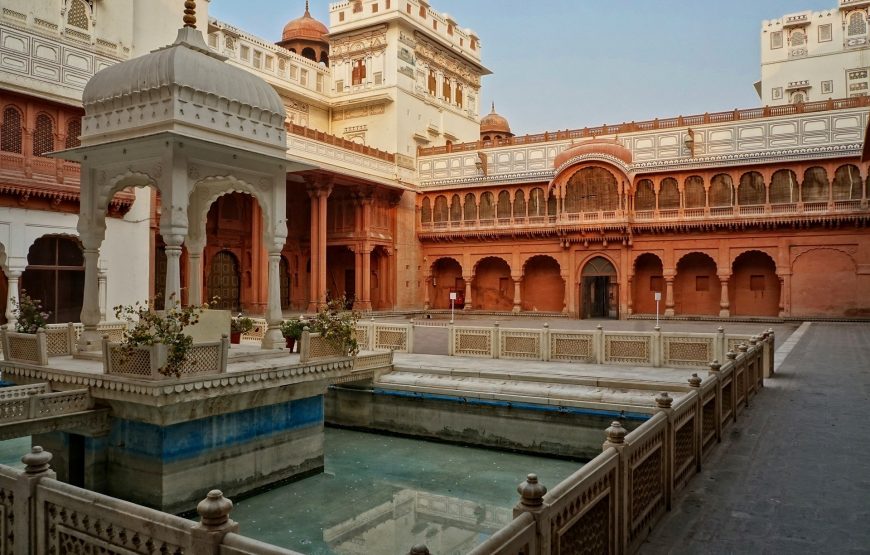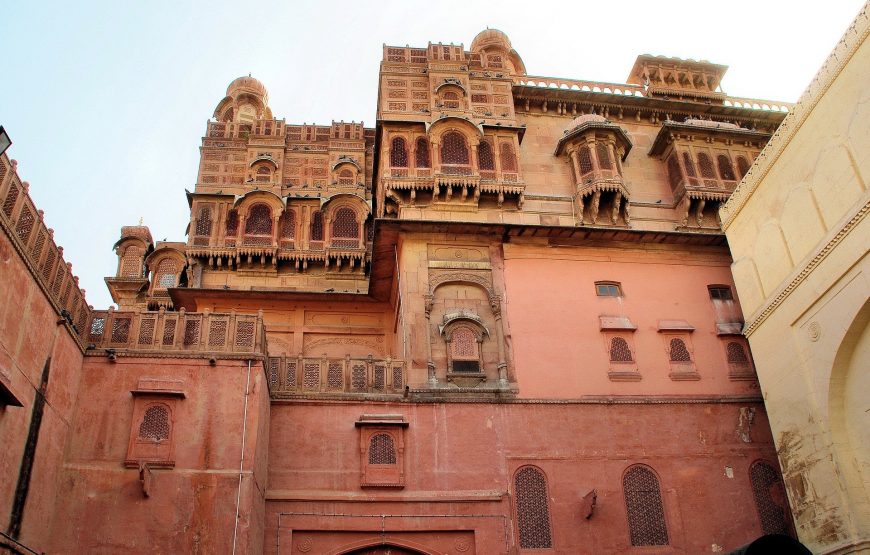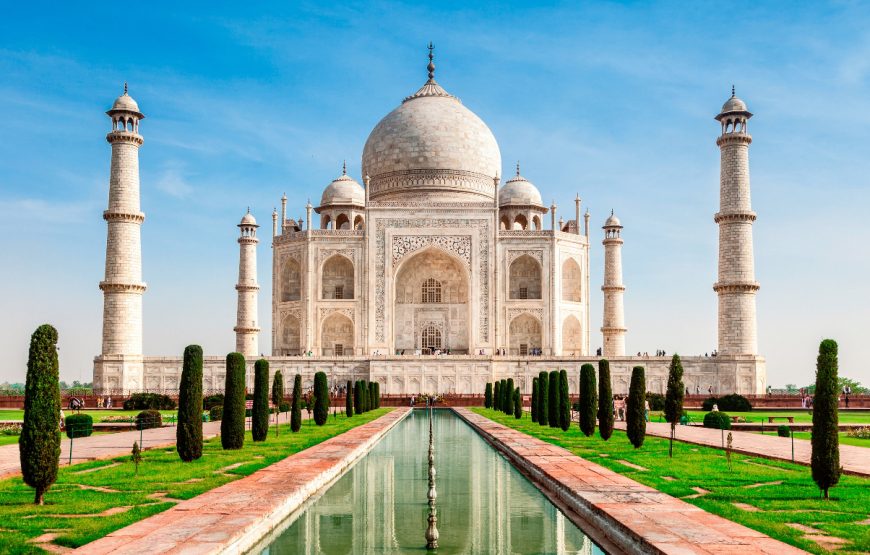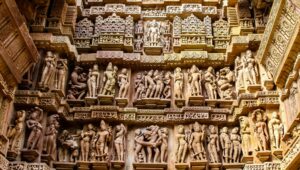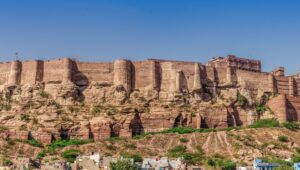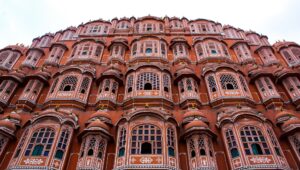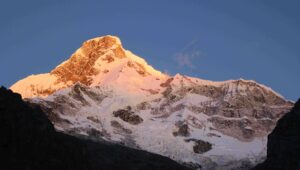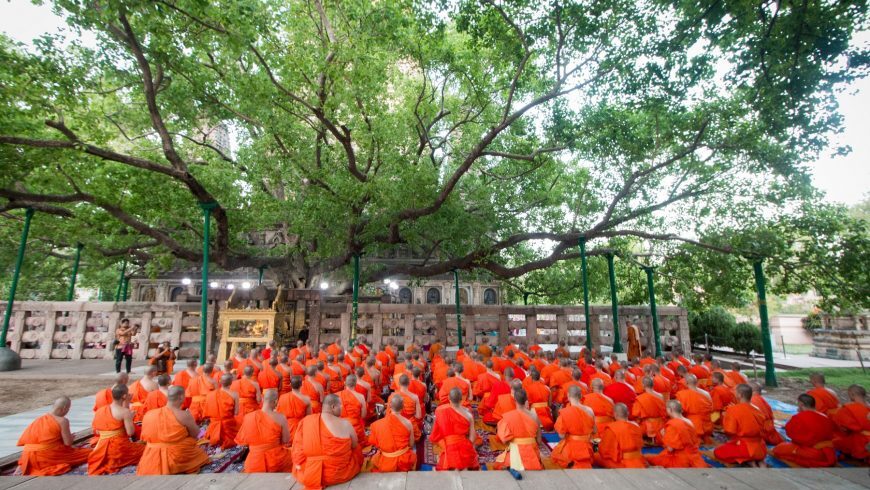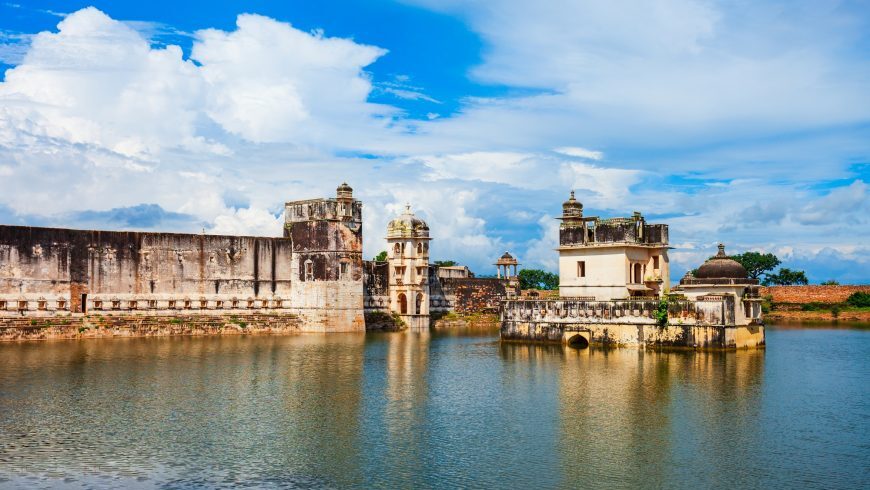Overview
Enjoy a mesmerizing visit to Delhi, Jaipur, Agra, Amritsar, and the Golden Temple. You will see UNESCO World Heritage Sites, Qutub Minar, Jantar Mantar, Hawa Mahal, Golden Temple, and Taj Mahal. Witness the Beating Retreat Ceremony at Wagah Border and visit the Golden Temple (sacred worship place of the Sikh community)—experience the world’s largest community kitchen.
Highlights
- Check out Delhi's famous Qutub Minar, the tallest brick minaret in the world
- Discover the architectural grandeur of Agra Fort and the Taj Mahal in Agra
- Visit the Amer Fort and other famous palaces and forts of Jaipur
- Take a picture with the World’s Largest Cannon on wheels in Jaigarh Fort on Jaipur
- Visit Golden Temple and Wagah Border ceremony in Amritsar
Itinerary
Day 1 :
Arrival in Delhi
Meet the driver in Delhi And transfer to the hotel.
The rest of the time is free for leisure or visiting the old market on a cycle rickshaw ride for Chandni Chowk & Khari Baoli Spice Market, a busy shopping area with markets full of spices, dried fruit, silver jewellery, and vivid saris. At the same time, the narrow side streets are crowded with tiny shops selling essential oils, stationery, and traditional Indian sweets.
Overnight stay in Delhi hotel.
Day 2 :
Delhi to Agra (250 km/5 hrs).
Taj Mahal: In the early morning, start your 5 hrs journey to the famous city of Agra and the stunning Taj Mahal, covering a distance of 240 km.
Agra Fort: Then go to the Agra Fort, A historical fort in the city of Agra. It was the main residence of the emperors of the Mughal Dynasty until 1638, when the capital was shifted from Agra to Delhi.
The rest of the time is free to visit the market by yourself.
Overnight stay in Agra Hotel.
Day 3 :
Agra to Jaipur (250 km/6 hrs) En route to see the Fatehpur Sikri & Chand Baori
Fatehpur Sikri: In the early morning, drive to Fatehpur Sikri, a small city in northern India, just west of Agra, founded by a 16th-century Mughal emperor. Red sandstone buildings cluster at their center. Buland Darwaza gate is the entrance to Jama Masjid mosque. Nearby is the marble Tomb of Salim Chishti. Diwan-E-Khas hall has a carved central pillar. Jodha Bais Palace is a mix of Hindu and Mughal styles.
Chand Baori: Then go head to Chand Baori, Which was built during the 8th and 9th centuries and has 3,500 narrow steps arranged in perfect symmetry, which descend 20m to the bottom of the well.
The rest of the time is free to visit the market by yourself.
Overnight stay in Jaipur hotel.
Day 4 :
Jaipur Sightseeing
Amber Fort: The old capital of the Kachhwahas stands atop a range of craggy hills. The fort is remarkable as much for the majestic grandeur of its surroundings as for its sturdy battlements & beautiful palaces.
Nahargarh Fort: This fort crests a hill about 600 ft. above the city. The fort was built in 1734. The walls of the fort run along the ridge & within are architectural beauties like Hawa Mandir & Madhvendra Bhawan.
Jaigarh Fort: This is 15 km standing on a hilltop, overlooking the palaces and city of Amer. The world's most enormous cannon on wheels, the Jai Ban, is positioned here.
Hawa Mahal: It is famous as "The Palace of Winds" or "The Palace of Breeze". Built from red and pink sandstone, the palace sits on the edge of the City Palace, Jaipur, and extends to the Zenana, or women's chambers.
City Palace: It is situated in the heart of the old city; it occupies about one-seventh of the old city area. The palace is a blend of Rajput & Mughal architecture. It houses a 7-stored Chandra Mahal in the center, providing a fine view of the gardens and the city.
Jantar Mantar: A UNESCO World Heritage site built-in 1734. It is a collection of nineteen architectural astronomical instruments built by the Rajput king Sawai Jai Singh II, the founder of Jaipur. The instruments allow the observation of astronomical positions with the naked eye.
Jal Mahal: A palace floating on Man Sagar Lake for a photo opportunity. Jal Mahal is a palace in the middle of Man Sagar Lake in Jaipur. The palace and the lake around it were renovated and enlarged in the 18th century by Maharaja Jai Singh II of Amber. The palace and the scenic beauty of the lake attract various tourists.
Albert Hall: An architectural delight that has captured the attention of many a ruler and wanderlust, the construction of the Albert Hall Museum started in 1876. With the foundation stone being laid during the visit of Albert Edward (King Edward VII), the Prince of Wales, there was a lot of uncertainty that revolved around the actual purpose of this structure.
Johri Bazaar: Then stop by Johri Bazaar, A shopper's paradise and a must-visit; Johari Bazaar in Jaipur have a reputation that precedes itself. Located near Hawa Mahal, this market of exquisite jewellers and artifacts to choose from can immerse shoppers in its glittering glory. It is considered to be one of the oldest markets in Jaipur City.
Overnight stay in Jaipur hotel.
Day 5 :
Jaipur to Delhi (260 km/5 hrs)
In the early morning, leave Jaipur for Delhi.
Red Fort: Shah Jahan constructed Red Fort in 1638. It was the main residence of the Mughal Dynasty and is located in the city center. It is made from red sandstone, and that is where it gets its name from. It became a UNESCO World Heritage Site in 2007.
Qutub Minar: This is a five-story tapering tower with a height of 73 meters. The spiral staircase in this minaret has 379 staircases. It is a UNESCO World Heritage Site and is visited by many daily.
Overnight stay in Delhi hotel.
Day 6 :
Drop to New Delhi Railway Station
In the early morning, you will be picked up from the hotel at around 6.00 hrs and transferred to the railway station to board the train to Amritsar by a comfortable train journey (air-conditioned). A morning meal will be served on board.
Wagah Border Ceremony: On reaching Amritsar, our chauffeur will take you to your pre-booked hotel. Come evening. We will take you to the breathtaking beating retreat ceremony at Wagah Border. Wagah Border is the one & only land border open between India and Pakistan, and the beating retreat ceremony is a daily military exercise conducted here. Return to your hotel. Overnight in Amritsar.
See the glimmering Golden Temple by night and witness the evening Palki Sahib ceremony, where the Guru Granth Sahib (Sikh holy book) is put away for the night with this tour. Every evening the Guru Granth Sahib is transported from the main shrine to the inner sanctum on a gilded palanquin.
Overnight stay in Amritsar Hotel.
Day 7 :
Amritsar City Tour & take a Delhi train
Golden Temple: The Temple is the spiritual center of the Sikh faith and was built by Guru Arjun Singh in the late 16th century. The Golden Temple Amritsar India (Sri Harimandir Sahib Amritsar) is not only a central religious place of the Sikhs but also a symbol of human brotherhood and equality. Everybody, irrespective of caste, creed or race, can seek spiritual solace and religious fulfilment without any hindrance. It also represents the distinct identity, glory and heritage of the Sikhs.
Back door entry to Golden Temple, the World's Largest Community Kitchen: No visit to a gurudwara is complete without seeing the langar (community kitchen/meal), and the scale of the community meal at the Golden Temple has to be seen to be believed. Rows upon rows of people line up to collect clean trays and cutlery and make their way to the two-level langar hall.
Jallianwala Bagh: The holiest and revered destination for the Sikh religion, Amritsar, is also a popular name in the chapters of Indian history. Both history and spirituality are intertwined along the walls of Amritsar, pulling in enthusiastic travellers from around the world. While talking about Amritsar's history, the first thing we can recollect is the Jallianwala Bagh Massacre of 1919, that brutally killed around 1,000 civilians.
In the afternoon, arrive at the Amritsar railway station, from where you board a train to reach Delhi.
Upon arrival at Delhi railway station, we will transfer to a hotel and have a peaceful night's stay in Delhi.
Day 8 :
Delhi sightseeing with end of this tour
India Gate: It is a war memorial located near the Rajpath. It is dedicated to the soldiers of British India who died in the wars. The India Gate, even though a war memorial, evokes the architectural style.
Jama Masjid: One of the largest mosques in the country, Jama Masjid is made up of red sandstone and marble. It was constructed by Shah Jahan and is visited by hundreds of people daily. The mosque's courtyard can accommodate about 25,000 people and be built for about one million Indian rupees.
Humayun's Tomb: The tomb of the Mughal Emperor Humayun in Delhi, India. The tomb was commissioned by Humayun's first wife and chief consort, Empress Bega Begum, in 1558 and designed by Mirak Mirza Ghiyas and his son, Sayyid Muhammad. She chose Persian architects.
Lotus Temple: Famous for its flower-like shape, Lotus Temple is a house of worship and open to all. Winning numerous awards, this place is a prominent attraction for all.
Connaught Place: A frenetic business and financial hub centred on a ring of collonaded Georgian-style buildings with global chain stores, vintage cinemas, bars and Indian restaurants. Stalls at Janpath Market sell saris, embroidered bags, and trinkets.
In the evening, guests will be dropped off at Delhi Airport or any desired location in Delhi, marking the end of this tour.
Include
- Breakfast
- A/C car and private transport
- Toll tax, parking, and fuel are all included
- 3-star accommodation is included in each place
- Guide service is included in each place
Excludes
- Any type of personal expensive is not included
- Any type of entrance charge is not included
- Lunch/dinner/drinks
